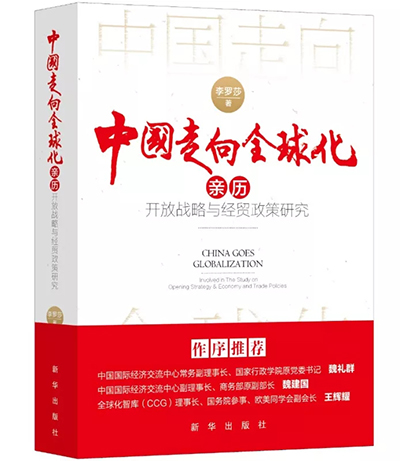CCG持续对企业全球化、 “走出去”和“引进来” 展开双向研究,以当前国际背景下的中美贸易、国际贸易、来华投资、对外投资、数字贸易为主题,进行分析、研究与解读。CCG 不断寻求更多力量来推动全球自由贸易发展,率先推动中国加入 CPTPP,并发布系列研究报告。此外,CCG 课题组常年编写国内唯一的“企业国际化蓝皮书”《中国企业全球化报告》,并在中国社会科学文献出版社出版。CCG还研发出版了《世界华商发展报告》、《大潮澎湃——中国企业“出海”四十年》、China Goes Global 、The Globalization of Chinese Enterprises 等企业全球化研究中英文图书系列。CCG还创办了国内最具影响力的专注于企业全球化发展的“中国企业全球化论坛”,围绕国际贸易与投资相关国际议题设置多场分论坛,云集国内外极具影响力的跨国公司领袖、驻华大使、前政要官员、国际组织与商会负责人、国际顶尖智库专家及知名学者深度研讨,已发展成为推动企业全球化发展的国际高端论坛。
-

何伟文: 政治风浪无法阻挡中美经贸合作
专家简介
2019年1月14日 -

基于三条理由,魏建国预判中美经贸磋商会有积极成果
专家简介
2019年1月7日 -

Harvey Dzodin: Will China’s steps for the economy pay
By Harvey Dzodin,a senior research fellow at the Center for China and Globalization(CCG). Just as the year 2018 is fast winding down, significant policy decisions proposing economic reforms affecting the economy in China, and therefore the global economy, have considerably been ramped up. While most consequences won’t be felt for some time, there is a strong sense of positive movement on the Chinese side as we head into 2019, the 70th anniversary year of New China, and into 2020 when China’s goal of building a moderately prosperous society in all respects is expected to be achieved. Taken as a whole, these decisions should not only stabilize and energize China’s economy but also further open China’s vast market to foreign and multinational companies. The annual Central Economic Work Conference (CEWC) that included top central government leaders, and other leaders and experts met in Beijing from December 19 to 21 to set economic policy for the coming year. The CEWC report made specific recommendations for both stabilizing the Chinese economy and further developing its domestic market as the top priorities. Chinese Premier Li Keqiang will announce detailed recommendations and implementation strategies at the two sessions in March. A man walks through an Apple Store in Beijing, China, November 30, 2018. /VCG Photo A few days after the CEWC adjourned, the National Development and Reform Commission (NDRC), China’s economic planning agency, in cooperation with the Ministry of Commerce, released a draft Foreign Investment Law (FIL) that has the potential to significantly open up much of China’s domestic markets to foreign investment and at the same time promises intellectual property protection and bans forced technology transfers from foreign companies to domestic Chinese entities. The CEWC recommendations were made in light of the current ongoing trade dispute between China and the U.S. The draft FIL, although part of a longer-term process begun before U.S. President Donald Trump took office, are also made in light of the trade dispute. Even though it’s the Christmas-New Year holiday season in Washington, D.C., and parts of the U.S. federal government are currently shut down and will remain so for some time due to a domestic political matter, active and robust bilateral negotiations are being held with progress being reported. Several steps could influence a more positive outcome of these negotiations in the bilateral trade dispute before the truce expires on March 2, 2019. Draft laws deliberated upon by the National People’s Congress (NPC) often take three or more readings, so normally the proposed FIL might not be passed until 2020 at the earliest. Some legislators, however, are calling for speedy consideration no later than the next NPC plenary session in March. This is possible although enactment is complicated by the unusually long comment period for this legislation runs until February 24. Of course, it will take months or years to see if the law’s promises are fulfilled, but this legislation is a potential giant step in the right direction. Tiananmen Square, Beijing, China /VCG Photo Intellectual property disputes are complex and often not easy to resolve. The U.S. side will be looking to see if enforcement provisions can be expeditious, fairly and expertly handled by the Chinese judicial system. In a lucky coincidence effective this Tuesday, a new branch of the Chinese Supreme People’s Court (SPC) dedicated to resolving IP disputes will open under the leadership of a respected SPC IP judge, Luo Dongchuan and is best suited to professionally resolve these complicated disputes. I believe these steps represent a good-faith effort by China to address U.S. concerns. It will be up to the U.S. side to also show good faith, something that often has been in short supply for the past 23 months. From CGTN, 2018-12-29
2019年1月2日 -

He Weiwen: China-US trade growth over the past augurs Coop. to continue
By He Weiwen, a senior research fellow at the Center for China and Globalization(CCG). The China-US two-way trade has witnessed the most gigantic growth in human history over the past 40 years since diplomatic relations was established in 1979, but also the largest trade friction in the history of world trade in 2018. The China-US two-way trade volume increased by 238-fold in the past 39 years, from 2.45 billion U.S. dollars in 1979 to 583.70 billion U.S. dollars in 2017. The first 11 months of 2018 saw trade volume reach 582.87 billion U.S. dollars, with the whole year volume set to create a new historic high, despite the massive trade frictions imposed by the Trump Administration. Trade and investment relations between the two countries can be roughly divided into four periods over the past 40 years. A Chinese Ministry of Commerce regular press conference, December 13, 2018. /VCG Photo. Period One, 1979-1988. The first decade of diplomatic ties saw a sound business relationship with no major issues. Trade volume increased from 2.45 billion U.S. dollars in 1979 to 12.3 billion U.S. dollars in 1989, representing a 5-fold increase in 10 years. Large numbers of U.S. multinational enterprises started making investments or having a presence in China, including Boeing, Coca-Cola, Weyerhaeuser, IBM, etc. Period Two, 1989-1999. It was a difficult decade. Bilateral trade relations deteriorated drastically after 1989. The U.S. intensified restrictions on high-tech exports to China, resulting in a fall of trade in 1990. During the 1990s, China and the U.S. have three rounds of negotiations: the U.S. 301, super 301 and 307 investigations. Both sides finally reached agreements in each of them. In 1999, the NATO bombing of the Chinese Embassy to Yugoslavia caused a crisis in bilateral diplomatic relations. Nonetheless, all the turbulence or difficulties did not stop the fast trade growth. China-U.S. trade reached 61.48 billion U.S. dollars in 1999. What is more important, both governments reached the historic agreement on China’s accession to WTO, a decisive step towards China’s WTO membership. Period Three, 2000-2016. Bilateral trade gained further momentum. Although bilateral diplomatic relations again fell into a new critical difficulty due to an incident involving a U.S. spy airplane that killed a Chinese pilot over the South China Sea in early 2001. The 9/11 incident in the U.S. brought bilateral relations back on track and China became a full member of WTO on December 11, 2001. China’s WTO accession was a strong force behind bilateral business relations. The two-way trade volume hit 519.6 billion U.S. dollars, an increase of 597.7 percent over 2000, or 12 percent per annum. China’s direct investment in the U.S. started to soar in 2014 and culminated in 45.6 billion U.S. dollars in 2016. Period Four, 2017-2018. The Trump Administration set China as the largest target of the trade war and launched a 301 investigation which resulted in 10-25 percent additional tariffs on $250 billion of Chinese exports to the U.S., never seen in the bilateral trade relations over the past 39 years, nor in the history of world trade. Despite that, the two-way trade has been growing astonishingly well. It reached 583.7 billion U.S. dollars in 2017, an all-time high, rising 12.3 percent over the previous year, and 582.8 billion U.S. dollars in the first 11 months of 2018, 12.9 percent up year-on-year. A new historic high is set to happen this year. Due to the Trump Administration’s strict restrictions, China’s investment in the U.S. saw a 40-percent decline in 2016 and a further 90-percent fall in the first half of 2018. On the other hand, the U.S. investment in China has kept a marginal rise. The fundamental reasons behind current China-U.S. trade frictions are: First, the U.S. does not tolerant China’s rise as a socialist power under the leadership of CPC. Second, the U.S. tries its best to stop China from threatening the U.S.’s world dominance in high tech and high-end manufacturing. Traders work on the floor of the New York Stock Exchange (NYSE) on December 7, 2018 in New York City. /VCG Photo. And thirdly, the U.S. does not accept China’s Belt and Road Initiative in reshaping the world order. As a result, bilateral trade tensions will continue, although it is almost certain that the current 90-day bilateral trade negotiation will reach an agreement. On the other hand, it is less likely that the relationship between the two countries will “derail” and enter a new cold war. The fundamentals lie in the fact that both economies have been intertwined into the global supply chain and thus could not be derailed by any policies. In 2015 alone, bilateral trade and investment supported 2.6 million jobs and contributed 1.2 percentage points GDP growth in the U.S.. By the end of 2017, the total U.S. investment stock in China hit over 200 billion U.S. dollars with sales in China’s market exceeding 600 billion U.S. dollars and total profit exceeding 70 billion U.S. dollars. GM had a global sale of 8.9 million units in 2017, with 4.04 million units, or 45.4 percent sold in China. China’s market shares in the top 10 U.S. semiconductor companies in 2017 ranged from 80 percent for Skyworks Solutions, 63 percent for Qualcomm, 52 percent for Broadcom, 50 percent for Micron, to 23 percent for Intel. As a result, no political force can change these economics. Looking ahead, China and US trade relations, whatever the twists and turns, will ultimately return to the track of win-win cooperation and stable growth, benefiting the two nations and contributing to the world’s economic growth as well. From CNTN, December 18, 2017
2018年12月25日 -

《中国走向全球化——亲历开放战略与经贸政策研究》发布
2018年12月19日,全球化智库(CCG)和新华出版社联合发布了CCG高级研究员、商务部前副司长、中国国际经济交流中心前研究员李罗莎的最新著作《中国走向全球化--亲历开放战略与经贸政策研究》。该图书收录了李罗莎女士亲历改革开放四十年间,参与研究或独立研究与中国对外开放问题相关的文章,通过解读中国改革开放四十年来的经贸发展,深入分析、聚焦破解难点问题,围绕中国如何在未来提高对外开放水平提出了相关战略和政策建议。
2018年12月24日


